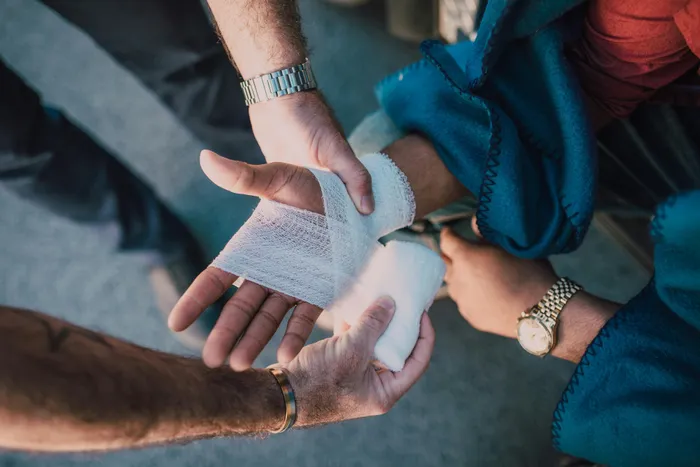Step-by-step guide for burns and the proper first aid actions to follow

Sterile gauze pads for additional coverage. Picture: RDNE Stock project /Pexels
As the colder months set in, there is often a noticeable increase in the number of burn injuries treated in emergency rooms.
During winter, many households turn to heating devices like heaters, hot water bottles, and fireplaces to keep warm. While these sources provide much-needed heat, they also pose a risk if not used properly.
Knowing and following proper first aid for burns is crucial because it can alleviate immediate pain, reduce the risk of infection and scarring, potentially lessen the severity of the injury, and help stabilise the victim until medical help arrives.

This facilitates a smoother transition to professional medical care, should it be required.
This can lead to better outcomes and ultimately increase the chances of survival and recovery for the burn victim Lizeth Kruger, the Dis-Chem Clinic executive, told “Independent Media Lifestyle”.
Common causes of burns that people should be aware of
Burn injuries are a major, yet preventable, issue especially, during winter. During the colder months, incidents of burns significantly rise. The primary sources of these injuries include:
Hot objects and liquids: Direct contact with stoves, ovens, boiling water, open flames, and steam leads to many burns.
Shack fires: Fires in informal settlements, often caused by stoves or paraffin usage, are a major cause.
Paraffin use: Many homes use paraffin as an energy source, contributing to burn risks.
Faulty electrical equipment: Burns from malfunctioning switches, plugs, and exposed wires.
Chemical exposure: Strong acids, alkalis, and other corrosive substances in household cleaners and industrial chemicals.
Raising awareness and educating the public about these risks can help prevent these injuries and ensure a safer winter season, said Kruger.
Burn injuries continue to be a major public health problem in South Africa, often resulting in hospital stays, long-term disabilities, and even death. While anyone can suffer from burn injuries, children are especially at risk.
At the Red Cross Children’s Hospital in the Western Cape, over 1,000 children receive treatment for burns each year. Notably, 80% of these cases involve children aged 0-5 years, highlighting the increased vulnerability of young children to accidental burns.
Quick first aid tips for burns
If you or someone nearby gets burned, the first thing to do is check where the injury is and how bad it is.
According to Kruger, if the burn seems serious or covers the hands, feet, major joints, sensitive areas, or wraps around an arm or leg, you should seek medical help right away.
- Ensure your safety and remove the burn victim from the source of danger.
- Cool the injured area under cold running water for at least 20 minutes to relieve discomfort and prevent additional tissue damage. Do not use ice, iced water, creams, or butter on the burn, as these can worsen the injury.
- Remove any constrictive items near the burned area, such as nappies, clothing, belts, and jewellery, as swelling may occur. If an item is stuck to the skin, do not remove it. Cut around it instead.
- Cover the burn area with a clean, non-stick dressing or cloth to protect it from infection. Do not wrap the burnt area too tight and do not pop any blisters. This can increase the risk of infection.
- Use over-the-counter medications which include ibuprofen and acetaminophen to alleviate the pain and inflammation.
- However, if the pain persists or the burn is severe, seek medical attention immediately.
- Do not use any greases, sprays, butter, or ointments on a burn, as they keep the heat in.
- Do not breathe, blow, or cough on the burn.
- Do not give the person anything by mouth if there is a severe burn.
- Do not place a severe burn in cold water. This can cause shock.
- Do not place a pillow under the person's head if there is an airway burn. This can close the airway.
What supplies should someone have in their home first aid kit specifically for treating burns?
For treating burns, a home first aid kit should be well-stocked with the following essential items and supplies to ensure proper care and management of the injury:
- Disposable gloves.
- Scissors for cutting around stuck clothing/items and bandages to the appropriate size.
- Bottled sterile water for cooling if running water is not available.
- Clean cloths or gauze to soak with water for cooling.
- Non-stick sterile dressings to cover the burn and protect it from infection without sticking to it.
- Saline solution for rinsing and cleaning the burn wound.
- Antiseptic wipes to clean the surrounding skin area - not the burn itself - to prevent infection.
- Sterile gauze pads for additional coverage.
- Adhesive tape to secure dressings, but not too tightly.
- Aloe vera gel only for minor burns to provide cooling and soothing
Home remedies not recommended for burns
Many people believe that applying butter or oils to a burn can help, but this is not true. Here’s why:
Traps heat: Butter and oils can trap heat in the burn, making the injury worse.
Risk of infection: These substances are not sterile and can introduce harmful bacteria, leading to infections.
Complicates medical care: They can interfere with medical treatments because doctors need a clean wound to assess and treat burns properly.
Allergic reactions: Some people may be allergic to ingredients in butter or oils, complicating the situation further.
Instead, stick to proven first aid measures like cooling the burn with cool water and seeking medical help if necessary, Kruger said.
Related Topics: